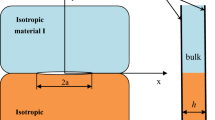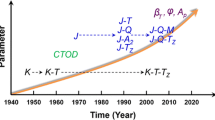Abstract
This paper presents a framework how to estimate crack driving forces in terms of crack-tip opening displacement andJ-integral for mismatched dissimilar joints with interface cracks. The mismatch in elastic, thermal, and plastic hardening properties is not considered, but the mismatch in plastic yield strengths is emphasized here. The main outcome of the present work is that the existing methods to estimate crack driving forces for homogeneous materials can be used with slight modification. Such modification includes (i) mismatch- corrected limit load solutions, and (ii) evaluating the contribution of each material in dissimilar joints to the total crack driving force, which depends on the strength mismatch of the dissimilar joints.
Similar content being viewed by others
Reference
ABAQUSUser’s Manual, 1995, Version 5.5, Hibbitt, Karlsson and Sorensen, Inc., Pawtucket, RI.
Dreier, G. and Schmauder, S., 1993, “T-Stress Related to Thermal Residual Stresses in Bimaterials,”Scripta Metallurgica et Materialia, Vol. 28, pp. 103–108.
EFAM ETM 97: The ETM Method for Assessing the Significance of Crack-Like Defects in Engineering Structures, GKSS Report.
Hauf, D. E., Parks, D. M. and Lee, H., 1994, “A Modified Effective Crack Length Formulation inin Elastic-Plastic Fracture Mechanics,”Mechanics of Materials, Vol. 20, pp. 273–289.
Lee, H., Ham, J. and Kim, Y-J, 1999, “MBL Based Investigations of Interfacial Crack-Tip Constraint andJ-integrals in Plastically Hardening Bimaterials,”KSME Journal A, Vol. 23, No. 9, pp. 1525–1535.
Lee, H., and Kim, Y-J, 1998, “Effect of Strength Mismatch on Fully Plastic Fields in Dissimilar Joints under Combined Loading,”KSME International Journal, Vol. 12, No. 4, pp. 553–564.
Kumar, G. D., German, M. D. and C. F. Shih, 1981, EPRI: An Engineering Approach for Elastic-Plastic Fracture, EPRI Report NP 1931.
Miller, A. G., 1988, “Review of Limit Loads of Structures Containing Defects,”International Journal of Pressure Vessel and Piping, Vol. 32, pp. 197–327.
O’Dowd, N. P., Shih, C. F., and Stout, M. G., 1992, “Test Geometries for Measuring Interfacial Fracture Toughness,”International Journal of Solids and Structures, Vol. 29, pp. 571–589.
Parks, D. M., 1992, “Advances in Characterization of Elastic-Plastic Crack-Tip Fields,” inTopics in Fracture and Fatigue, (McClintock Festschrift)., Springer-Verlag, 59–98.
Rice, J. R., 1988, “Elastic Fracture Mechanics Concepts for Interfacial Cracks,”Journal of Applied Mechanics, Vol. 55, pp. 98–103.
Shih, C. F. and Asaro, R. J., 1988, “Elastic-Plastic Analysis of Cracks on Bimaterial Interfaces: Part I-Small-Scale Yielding,”Journal of Applied Mechanics, Vol. 55, pp. 299–316.
Shih, C. F. and Asaro, R. J., 1989, “Elastic-Plastic Analysis of Cracks on Bimaterial Interfaces: Part II-Structures of Small-Scale Yielding Fields,”Journal of Applied Mechanics, Vol. 56, pp. 763–779.
Shih, C. F. and Asaro, R. J. and O’Dowd, N. P., 1991, “Elastic-Plastic Analysis of Cracks on Bimaterial Interfaces: Part III-Large Scale Yielding,”Journal of Applied Mechanics, Vol. 58, pp. 450–463.
Symington, M. F., 1987, “Eigenvalues for Interface Cracks in Linear Elasticity,”Journal of Applied Mechanics, Vol. 54, pp. 973–974.
Williams, M. L., 1959, “The Stresses Around a Fault or Crack in Dissimilar Media,”Bulletin of the Seismological Society of America, Vol. 49, pp. 199–204.
Zywicz, E. and Parks, D. M., 1989, “Elastic Yield Zone Around an Interfacial Crack-Tip,”Journal of Applied Mechanics, Vol. 56, pp. 577–584.
Zywicz, E. and Parks, D. M., 1992, “Small-Scale Yielding Interfacial Crack-Tip Fields,”Journal of the Mechanics and Physics of Solids, Vol. 40, pp. 511–536.
Author information
Authors and Affiliations
Corresponding author
Rights and permissions
About this article
Cite this article
Kim, YJ., Lee, H. Decomposition of interfacial crack driving forces in dissimilar joints. KSME International Journal 14, 30–38 (2000). https://doi.org/10.1007/BF03184768
Received:
Revised:
Issue Date:
DOI: https://doi.org/10.1007/BF03184768




